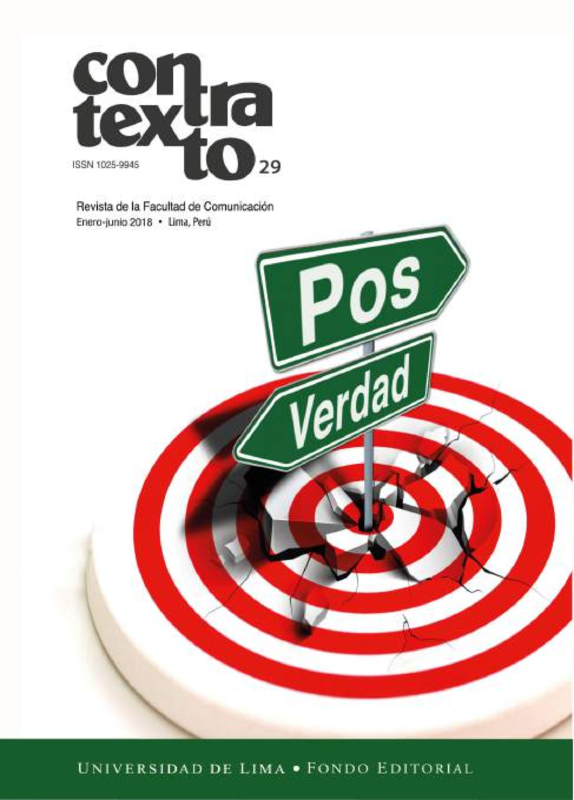El periodismo científico y el uso de las emociones en las narrativas noticiosas en la era de la posverdad. Un estudio comparativo entre el Reino Unido y la India
DOI:
https://doi.org/10.26439/contratexto2018.n029.1863Resumen
En este artículo, examinamos el poder del periodismo científico para atraer y vincularse a las audiencias noticiosas. Observamos cómo las expectativas normativas de ser objetivos e imparciales se han convertido en un obstáculo para la comunicación de la ciencia, a pesar de que son absolutamente necesarias para lograr rigurosidad. El problema es que, aun cuando los periodistas reconocen la necesidad de incorporar elementos subjetivos relacionados con lo emotivo y humano, la naturaleza de la fuente científica impide y limita la capacidad del periodismo de hacer la noticia científica relevante en una era en que las emociones en la comunicación pública son cada vez más relevantes. El artículo refleja los resultados de una investigación desarrollada entre los años 2015 y 2018, y se basa en entrevistas semiestructuradas a 52 periodistas en la India y el Reino Unido, así como en la lectura cerrada de una muestra de noticias científicas producidas en el Reino Unido.
Descargas
Referencias
Aaronovitch, D., y Langton, J. (2009). Voodoo Histories: The Role of the Conspiracy Theory in Shaping Modern History. Nueva York, NY: Vintage Publishing.
Allcott, H., y Gentzkow, M. (2017). Social Media and Fake News in the 2016 Election. Journal of Economic Perspectives, 31(2), 211-36. doi:10.1257/jep.31.2.211
Anderson, C. W. (2011). Deliberative, Agonistic, and Algorithmic Audiences: Journalism’s Vision of its Public in an Age of Audience Transparency. International Journal of Communication, 5(19), 527-549. Recuperado de http://ijoc. org/index.php/ijoc/article/view/884/537
Badash, L. (2009). A Nuclear Winter’s Tale. Science and Politics in the 1980s. Cambridge, MA: MIT Press.
Bakir, V., y McStay, A. (2017). Fake News and The Economy of Emotions: Problems, Causes, Solutions. Digital Journalsism, 6(2), 154-175. https://doi.org/10.1080/2167 0811.2017.1345645
Bauer, M. W., y Bucchi, M. (Eds.). (2008). Journalism, Science, and Society: Science Communication between News and Public Relations. Abingdon, Oxfordshire: Routledge.
Begg, N., Ramsay, M., White, J., y Bozoky, Z. (1998). Media Dents Confidence in MMR Vaccine. BMJ, 316(7130), 561. https://doi.org/10.1136/bmj.316.7130.561
Benchimol, A. (2015). Before Blackwood’s: Scottish Journalism in the Age of Enlightenment. Abingdon, Oxfordshire: Routledge.
Brechman, J., Lee, C. J., y Cappella, J. N. (2009). Lost in Translation? A Comparison of Cancer-Genetics Reporting in the Press Release and its Subsequent Coverage in the Press. Journal of Science Communication, 30(4), 453-474. https://doi. org/10.1177/1075547009332649
Briggs, H. (25 de marzo del 2018). Tree loss pushing beetles to the brink. BBC News. Recuperado de http://www.bbc.com/news/science-environment-43262254
Christians, C. (2015). North-South Dialogues in Journalism Studies. African Journalism Studies, 36(1), 44-50. https://doi.org/10.1080/23743670.2015.1008129
Cohen, B. (2015 [1963]). Press and Foreign Policy. Princeton, NJ: Princeton University Press.
Conway, B. A., Kenski, K., y Wang, D. (2015). The Rise of Twitter in the Political Campaign: Searching for Intermedia Agenda-Setting Effects in the Presidential Primary. Journal of Computer-Mediated Communication, 20(4), 363-380. https://doi. org/10.1111/jcc4.12124
Conway, E. M., y Oreskes, N. (2010). Merchants of Doubt. How a Handful of Scientists Obscured the Truth on Issues from Tobacco Smoke to Global Warming. Nueva York, NY: Bloomsbury Press.
Dahlstrom, M. F., y Ho, S. S. (2012). Ethical Considerations of Using Narrative to Communicate Science. Science Communication, 34(5), 592-61. https://doi. org/10.1177/1075547012454597
d’Ancona, M. (2017). Post-truth: The New War on Truth and How to Fight Back. Nueva York, NY: Random House.
Davis, U. (5 de marzo del 2018). Spring is springing earlier in polar regions than across the rest of Earth. Phys.org. Indo-Asian News Service. Recuperado de https://phys.org/news/2018-03-earlier-polar-regions-rest-earth.html
Debarbieux, B., y Rudaz, G. (2015). The Mountain: A Political History from the Enlightenment to the Present. Chicago, IL: University of Chicago Press.
Deuze, M. (2005). What is Journalism? Professional Identity and Ideology of Journalists Reconsidered. Journalism, 6(4), 442-464. https://doi.org/10.1177/1464884905056815
Dunwoody, S. (2014). Science Journalism. Nueva York, NY: Routledge.
Elías, C. (2008). Fundamentos de periodismo científico y divulgación mediática. Madrid: Alianza Editorial.
Ettema, J. S., y Glasser, T. L. (1998). Custodians of Conscience. New York, NY: Columbia University Press.
Feldman, S., Huddy, L., y
Marcus, G. E. (2015). Going to War in Iraq: When Citizens and the Press Matter. Chicago, IL: University of Chicago Press.
Fenster, M. (1999). Conspiracy Theories: Secrecy and Power in American Culture. Mineápolis, MN: University of Minnesota Press.
Fowler, R. (2003). Language in the News: Discourse and Ideology in the Press. Abingdon, Oxfordshire: Routledge.
Fuller, J. (1996). News Values: Ideas for an Information Age. Chicago, IL: University of Chicago Press.
Galtung, J., y Ruge, M. H. (1965). The Structure of Foreign News: The Presentation of the Congo, Cuba and Cyprus Crises in Four Norwegian Newspapers. Journal of Peace Research, 2(1), 64-90. https://doi.org/10.1177/002234336500200104
Gee, J. (1999). An Introduction to Discourse Analysis. Theory and Method. Abingdon, Oxfordshire: Routledge.
Glück, A. (2016). What Makes a Good Journalist? Empathy as a Central Resource in Journalistic Work Practice. Journalism Studies, 17(7), 893-903. https://doi.org/10. 1080/1461670X.2016.1175315
Griffin, M., Shickle, D. A., y
Moran, N. (2008). European Citizens Opinions on Water Fluoridation. Community Dentistry and Oral Epidemiology, 36(2), 95-102. https:// doi.org/10.1111/j.1600-0528.2007.00373.x
Harcup, T., y O’Neill, D. (2001). What is News? Galtung and Ruge Revisited. Journalism Studies, 2(2), 261-280. http://dx.doi.org/10.1080/14616700118449
Hermida, A. (2012). Tweets and Truth: Journalism as a Discipline of Collaborative Verification. Journalism Practice, 6(5-6), 659-668. https://doi.org/10.1080/1751278 6.2012.667269
Hibberd, M., y Nguyen, A. (2013). Climate Change Communications & Young People in the Kingdom: A Reception Study. International Journal of Media & Cultural Politics, 9(1), 27-46. https://doi.org/10.1386/macp.9.1.27_1
Hjarvard, S. (2008). The Mediatization of Society. Nordicom Review, 29(2), 102-131. https://doi.org/10.1515/nor-2017-0181
Illmer, A. (2 de marzo del 2018). Examining China’s hypersonic transport plans. BBC News. Recuperado de www.bbc.co.uk/news/business-43151175
Inglehart, R., y Norris, P. (2016). Trump, Brexit, and the Rise of Populism: Economic Have-Nots and Cultural Backlash. HKS Working Paper No. RWP16-026. Recuperado de https://papers.ssrn.com/sol3/papers.cfm?abstract_id=2818659
Jukes, S. (2013). A Perfect Storm: Journalism Facing Unprecedented Challenges. En K. Fowler-Watt y S. Allan (Eds.), Journalism: New Challenges (pp. 1-18). Recuperado de https://microsites.bournemouth.ac.uk/cjcr/files/2013/10/2013-Journalism-New_ Challenges-Fowler-Watt_and_Allan-v1-01.pdf#page=24
Kalichman, S. C. (2009). Denying AIDS: Conspiracy Theories, Pseudoscience, and Human Tragedy. Berlín: Springer Science & Business Media.
Linstead, S. A. (2015). The Dark Side of the Open Road: Critical Management Studies and Critical Public Relations. Academy of Management Proceedings, 2015(1). doi:10.5465/AMBPP.2015.16991abstract
López-Cantos, F. (2017). Comunicación pública de la pseudociencia: homeópatas y orgonitas 2.0. Razón y Palabra, 21(96), 355-372. Recuperado de http://www. redalyc.org/html/1995/199551160020/
Lugo-Ocando, J. (2015). Journalists do Live in a Parallel Universe: A Response to Practitioner Critiques of Journalism Academics. Journal of Applied Journalism & Media Studies, 4(3), 369-379. https://doi.org/10.1386/ajms.4.3.369_1
Lugo-Ocando, J., y Nguyen, A. (2017). Developing News: Global Journalism and the Coverage of “Third World”. Abingdon, Oxfordshire: Routledge.
Lundby, K. (Ed.). (2009). Mediatization: Concept, Changes, Consequences. Oxford: Peter Lang.
Luther, C. A., y Miller, M. (2005). Framing of the 2003 US-Iraq War Demonstrations: An Analysis of News and Partisan Texts. Journalism & Mass Communication Quarterly. 82(1), 78-96. https://doi.org/10.1177/107769900508200106
Martinisi, A., y Lugo-Ocando, J. (2015). Overcoming the Objectivity of the Senses: Enhancing Journalism Practice through Eastern Philosophies. International Communication Gazette, 77(5), 439-455. https://doi.org/10.1177/1748048515586944
Moon, A. (2017). Two-thirds of American adults get news from social media: survey. Reuters. Recuperado de https://uk.reuters.com/article/us-usa-internet-socialmedia/two-thirds-of-american-adults-get-news-from-social-media-survey-idUKKCN1BJ2A8
Moran, N., Shickle, D., y Richardson, E. (2008). European Citizens’ Opinions on Immunisation. Vaccine, 26(3), 411-418. https://doi.org/10.1016/j.vaccine.2007.11.001
Murray, C., Parry, K., Robinson, P., y Goddard, P. (2008). Reporting Dissent in Wartime: British Press, the Anti-War Movement and the 2003 Iraq War. European Journal of Communication, 23(1), 7-27. https://doi.org/10.1177/0267323107085836
Neuman, W. R., Guggenheim, L., Mo Jang, S., y Bae, S. Y. (2014). The Dynamics of Public Attention: Agenda-Setting Theory Meets Big Data. Journal of Communication, 64(2), 193-214. https://doi.org/10.1111/jcom.12088
Newman, N., Fletcher, R., Kalogeropoulos, A., Levy, D., y Nielsen, R. K. (2017). Reuters Institute Digital News Report 2017. Recuperado de https://papers.ssrn.com/sol3/ papers.cfm?abstract_id=3026082
Nguyen, A., y McIlwaine, S. (2011). Who Wants a Voice in Science Issues —and Why? A Survey of European citizens and its Implications for Science Journalism. Journalism Practice, 5(2), 210-226. https://doi.org/10.1080/17512786.2010.527544
Oliver, J. E., y Wood, T. J. (2014). Conspiracy Theories and the Paranoid Style(s) of Mass Opinion. American Journal of Political Science 58(4), 952-966. https://doi. org/10.1111/ajps.12084
Peters, C. (2011). Emotion Aside or Emotional Side? Crafting an “Experience of Involvement” in the News. Journalism, 12(3), 297-316. https://doi. org/10.1177/1464884910388224
Peters, C., y Broersma, M. J. (Eds.). (2013). Rethinking Journalism: Trust and Participation in a Transformed News Landscape. Abingdon, Oxfordshire: Routledge.
Pew Research Center. (2017). Trust in the News Media. Pew Research Centre, Media & Journalism. Recuperado de http://www.journalism.org/2017/05/10/americans-attitudes-about-the-news-media-deeply-divided-along-partisan-lines/ pj_2017-05-10_media-attitudes_a-05/
PTI. (5 de marzo del 2018). China to launch Long March 5B rocket into space in 2019. The Times of India. https://timesofindia.indiatimes.com/world/china/china-to-launch-long-march-5b-rocket-into-space-in-2019/articleshow/63172833.cms
PTI. (2 de abril del 2018). Scientists working on new device that could give humans “cat-like” hearing. The Indian Express. Recuperado de http://indianexpress. com/article/technology/science/scientists-working-on-new-device-that-could-give-humans-cat-like-hearing-5120573/
Rainie, L. (2017). US Public Trust in Science and Scientists [presentación de diapositivas]. Recuperado de http://www.pewinternet.org/2017/06/27/u-s-public-trust-in-science-and-scientists/
Rasmussen, D. C. (2014). Contemporary Political Theory as an Anti-Enlightenment Project. En G. Boucher y H. M. Lloyd (Eds.), Rethinking the Enlightenment: Between History, Philosophy, and Politics (pp. 39-59) Boulder, CO: Lexington Books.
Reed, R. (2001). (Un-)Professional Discourse? Journalists’ and Scientists’ Stories about Science in the Media. Journalism, 2(3), 279-298. https://doi. org/10.1177/146488490100200310
Roudakova, N. (2017). Losing Pravda: Ethics and the Press in Post-Truth Russia. Cambridge: Cambridge University Press.
Russial, J., Laufer, P., y Wasko, J. (2015). Journalism in Crisis? Javnost-The Public, 22(4), 299-312. https://doi.org/10.1080/13183222.2015.1091618
Sánchez Lobato, J., y Hernando, L. A. (2018). La configuración lingüístico-discursiva en el periodismo científico. Madrid: Iberoamericana.
Shermer, M. (1999). The Measure of a Life: Carl Sagan and the Science of Biography. Skeptic, 17(4), 32-39. Recuperado de http://www.theeway.com/skepticc/ newsworthy06.html
Sillesen, L. B., Ip, C., y Uberti, D. (2015). Journalism and the Power of Emotions. Columbia Journalism Review, 54(1), 15. Recuperado de https://www.cjr.org/ analysis/journalism_and_the_power_of_emotions.php
Soronen, A. (2017). Emotional Labour in Magazine Work: Suppressing and Evoking Emotions as Part of Project-Based Teamwork. Journalism Practice, 12(3), 290-307. https://doi.org/10.1080/17512786.2017.1297685
Speed, E., y Mannion, R. (2017). The Rise of Post-Truth Populism in Pluralist Liberal Democracies: Challenges for Health Policy. International Journal of Health Policy and Management, 6(5), 249. https://dx.doi.org/10.15171%2Fijhpm.2017.19
Speers, T., y Lewis, J. (2004). Journalists and Jabs: Media Coverage of the MMR Vaccine. Communication & Medicine, 1(2), 171-181. https://doi.org/10.1515/ come.2004.1.2.171
Sturgis, P., y Allum, N. (2004). Science in Society: Re-Evaluating the Deficit Model of Public Attitudes. Public Understanding of Science, 13(1), 55-74. https://doi. org/10.1177/0963662504042690
Tuchman, G. (1972). Objectivity as Strategic Ritual: An Examination of Newsmen’s Notions of Objectivity. American Journal of Sociology, 77(4), 660-679. https://doi. org/10.1086/225193
Tumber, H., y Prentoulis, M. (2003). Journalists under Fire: Subcultures, Objectivity, and Emotional Literacy. En D. K. Thussu y D. Freedman, War and the Media: Reporting Conflict (pp. 215-230). Londres: Sage.
Waisbord, S. (2013). Reinventing Professionalism: Journalism and News in Global Perspective. Hoboken, NJ: John Wiley & Sons.
Waisbord, S. (2018). The Elective Affinity between Post-Truth Communication and Populist Politics. Communication Research and Practice, 4(1), 17-34, doi:10.1080/22 041451.2018.1428928.
Ward, S. J. A. (2015). The Invention of Journalism Ethics: The Path to Objectivity and Beyond. Kingston, Ontario: McGill-Queen’s Press-MQUP.
WJS. (2018). The Worlds of Journalism Study. Recuperado de http://www.world sofjournalism.org
Zelizer, B. (1993). Journalists as Interpretive Communities. Critical Studies in Media Communication, 10(3), 219-237. https://doi.org/10.1080/15295039309366865
Zelizer, B. (2015). Terms of Choice: Uncertainty, Journalism, and Crisis. Journal of Communication, 65(5), 888-908. https://doi.org/10.1111/jcom.12157
Zuckerman, E. (2017). Mistrust, Efficacy, and the New Civics: Understanding the Deep Roots of the Crisis of Faith in Journalism. Knight Commission Workshop on Trust, Media, and American Democracy. Recuperado de https://assets.aspeninstitute. org/content/uploads/2017/07/zuckerman.whitepaper.FINAL_.pdf
Publicado
Número
Sección
Licencia
Todos los trabajos publicados están sujetos a una licencia CC BY 4.0 Creative Commons (actualizado el 1 de marzo de 2021).
El contenido de la revista se puede compartir en cualquier material o formato. Asimismo, se puede adaptar, contribuir y transformar. Ambas posibilidades sólo están permitidas en la medida en que cumplan las siguientes condiciones:
- Atribución: Se debe otorgar crédito donde sea debido, proporcionar un enlace a la licencia e indicar los cambios en caso se realice alguno. Esto debe hacerse de la manera que se considere apropiada, sin sugerir que el licenciante lo promueva a usted o su uso del material.
Derechos de propiedad
Los derechos patrimoniales de Contratexto se publican bajo una licencia Creative Commons BY 4.0, lo que permite a los autores mantener los derechos patrimoniales de su obra sin restricciones.
Si un trabajo publicado en Contratexto fuera copiado, distribuido, difundido o cualquier otra actividad contemplada en la licencia antes mencionada, se deberá mencionar de manera visible y expresa al autor o autores y a la revista.
Auto-archivo
Esta revista permite y anima a los autores/as a publicar artículos enviados a la revista en sus sitios web personales o en depósitos institucionales, tanto antes como después de su publicación en esta revista, siempre y cuando proporcionen información bibliográfica que acredite, si procede, su publicación en ella.


















